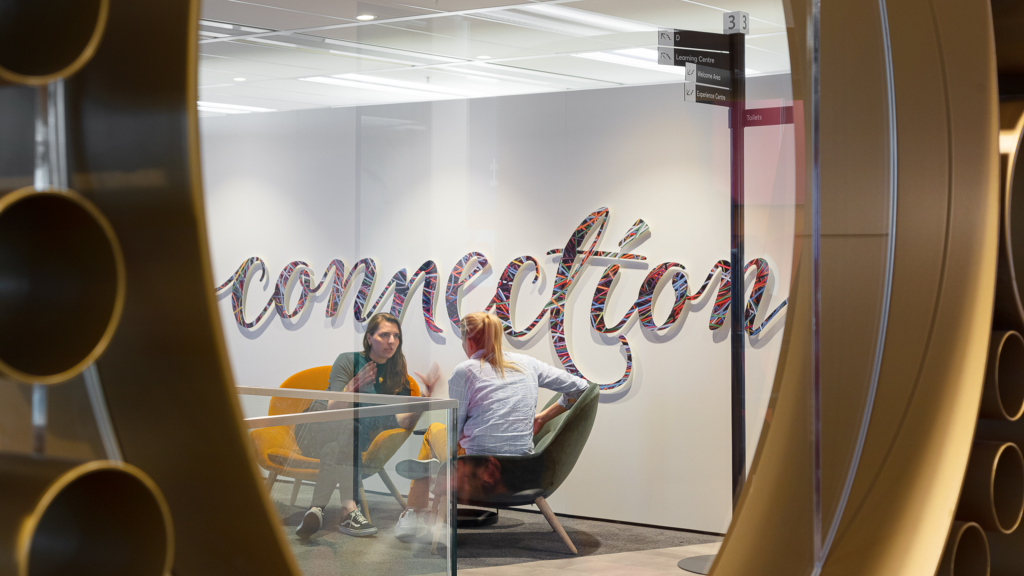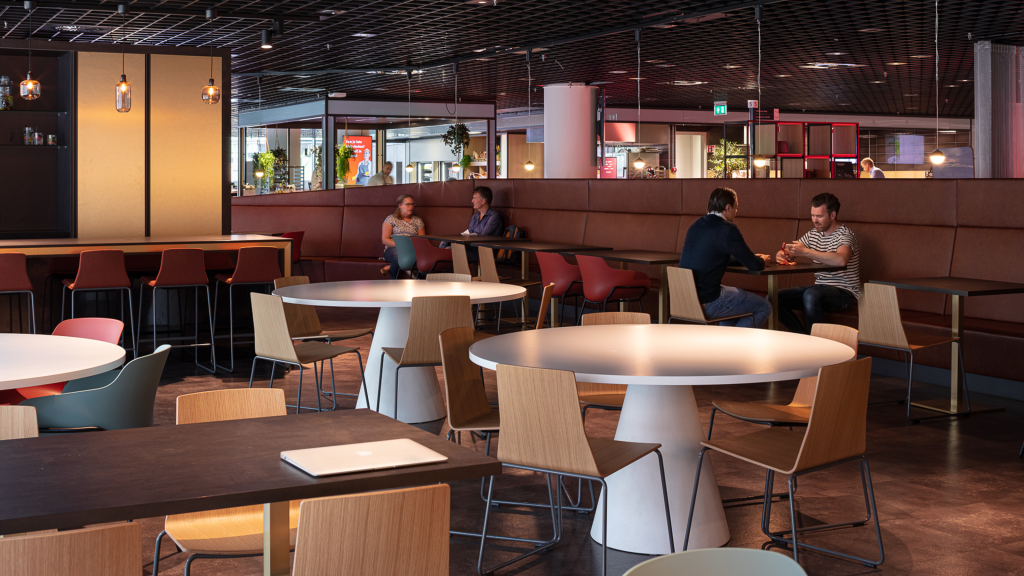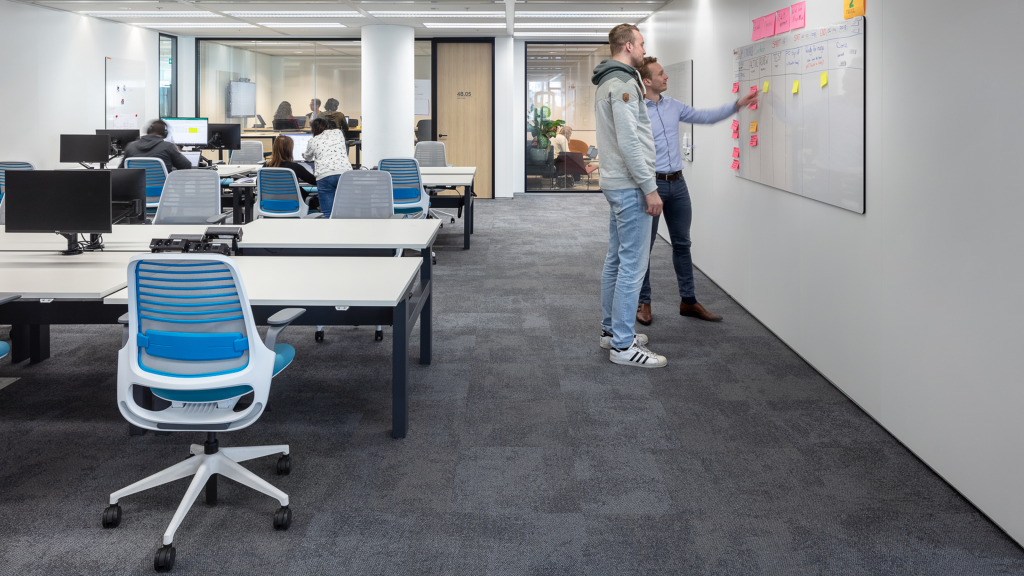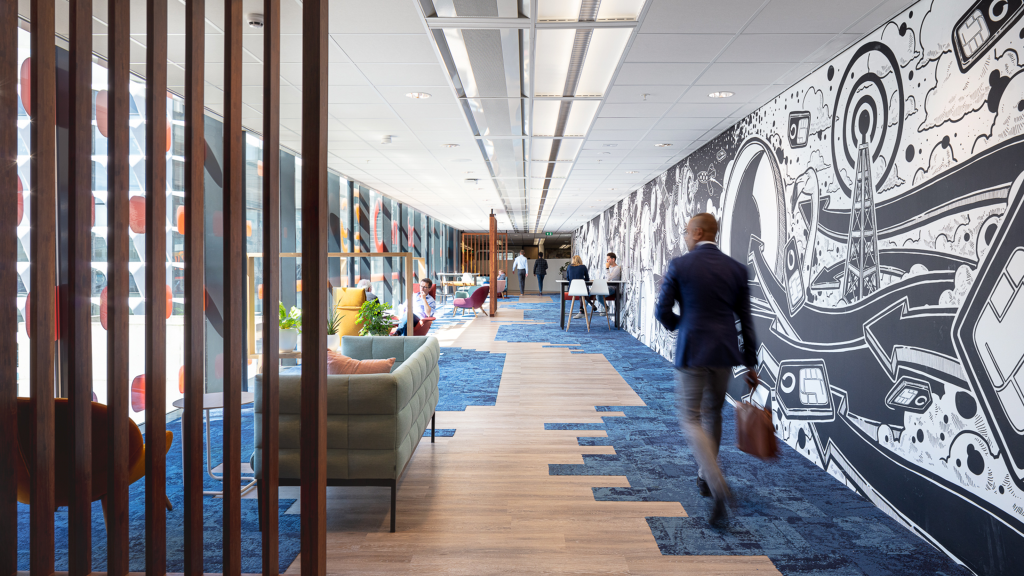VodafoneZiggo describes itself as the driver of Dutch digitalization, building the network of the future. From video conferencing to entertainment, from fixed to mobile, the Dutch company connects consumers and businesses. Vodafone, a leading mobile business, and Ziggo, a successful broadband and TV business, came together in 2016 and in the fall of 2018 moved into a new headquarters, consolidating multiple offices together for the first time.
Michelle Siau, an agile transformation coach at VodafoneZiggo, saw the move as an opportunity to use the new environment to support their agile process and culture. Steelcase worked with VodafoneZiggo, Res & Smit and OCS+Steelcase to create their new workplace in Utrecht. About six months after move-in, 360 had the chance to visit. We sat down with Siau to learn more about how their teams work and how their space helps them advance digitization.
360: Your new headquarters is a great opportunity to drive new behaviors and a new culture. What were your objectives for the new space from an agile perspective?
MS: For agile to succeed, groups need to come together and interact. We used to be a number of different companies, and now those groups have all come together in one building, able to share knowledge and work together. With agile, we need to make our ideas and plans visible and carve a big problem into smaller concrete steps we can accomplish. We do morning stand ups, review our plans for the day and discuss the impediments hindering us from reaching the goal. We have spaces where we can all sit and talk, hold workshops or meet with someone. Any stakeholder, manager or team member can walk by, see the team’s progress and see where they can help.
360: How do you define agile?
MS: I think agile, in its basic form, is about using common sense. We ask ourselves if what we are doing will get us to reach our goal and if it doesn’t, we challenge the status quo. This is what the agile values are all about. Think about if those processes and tools support the individual and interaction you want to have. If not, change it, so it does.
360: You work with people at all levels to understand what makes them tick and help them navigate change. What drives you as an agile coach?
Michelle Siau: What motivates me is the moment you see someone who can truly be themselves. Imagine you’re in an environment where you feel so safe and so at ease that you can be yourself without limitations. There would be nothing holding you back from exploring and getting the most out of yourself. If you don’t have all that clutter—whether it’s cultural baggage or an environment that’s an obstacle—to hold you back, then you can focus on yourself and becoming more innovative and fulfilled. When you see people like that, they are unstoppable.
360: How do you motivate people to not just practice agile, but actually become agile in how they work and think?
MS: You can’t change a person if nothing’s wrong and you don’t need to. When teams start to ask if what they’re doing will help them reach their goal or not, they start to feel the need to do something about the way they work together. If you then know why people do the things they do, then you also know what it means for them to change. So often, it boils down to people wanting to make a difference, wanting to do work that means something. That means you can go behind their function or job title. It’s about recognizing the individual and helping them to reach their goals. Practicing this way of thinking means they adopt the mindset and become an ambassador for it.
360: Culture change can be one of the hardest things an organization goes through. What are the key success factors for VodafoneZiggo as it’s on this agile journey?
MS: We’re in a bubbly market. A lot is changing. Companies are in the taxi business, but don’t own cars. They are in the hotel business, but don’t own beds. The world is changing so rapidly, that we need to look at how we are organized. With true agility, you have the luxury to choose if you want to be the first mover or the smart follower. Instead of adapting, you would be anticipating the market. At VodafoneZiggo, we see a lot of individuals and teams very committed to delivering value. Everyone wants to take part and the change is going faster than we anticipated. So, I guess the key success factors boil down to the people within your organization and the eagerness to contribute to a larger purpose.
360: Can you describe some specific spaces which support this collaboration?
MS: The space we’re in now is a huddle room. It was originally designed to be a place for people to gather and stand. There are whiteboards and the walls are covered with sticky notes. And, there’s posters about the agile values. Teams can use this space for their stand ups or any other event. It promotes an active posture where teams will stand next to their backlog and run through their progress and what help they need. This space is not able to be reserved. So, people can pop in here whenever they need to work together on something. We also come in here to discuss strategy, improvements or prioritization.
On the long wall within the space, you see a visualization where the work of 12 agile teams are combined from a scaled environment. We display what kind of progress we’re making on certain maturity and transformation topics. By sharing information, we help create awareness of what’s going on and can ask for help from our community. We started with about 6 agile teams and now we have 46. The amount of teams using agile values and working in frameworks such as scrum is growing faster than we could have envisioned. So, our space is already adapting to how we use it. This room is being used in so many ways because the design was agile enough to accommodate how our work is changing.
360: You’re about six months into using this new workplace. What’s next?
MS: They say the sky’s the limit, but maybe we should look to something beyond that. I’d like there to be a moment where VodafoneZiggo is admired by the people we look up to. I want people to feel like there’s no other place they can dream of working if they want to be themselves. We have an agile coach on our team who came to work here because two trainees already working with us said, “You have to come here. This office is amazing.” He literally came to visit and said, “I need to work here.” And, now he’s part of our team, coaching multiple teams. People attract each other and learn from one another. Our environment is helping us invite people in to collaborate and learn together.





